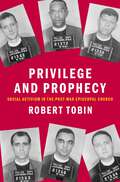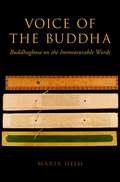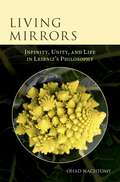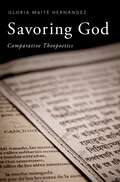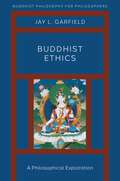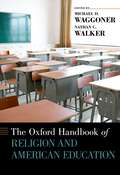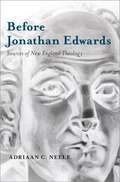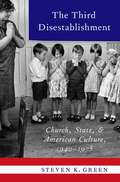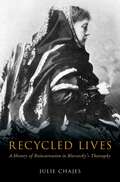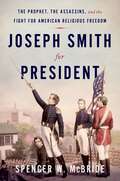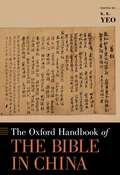- Table View
- List View
Privilege and Prophecy: Social Activism in the Post-War Episcopal Church
by Robert TobinThe Episcopal Church has long been regarded as the religion of choice among America's ruling elite, helping to set the tone for the moral and social life of the nation during the twentieth century. Shaped by their experiences of the Great Depression and World War II, a new generation of Episcopal leaders emerged after 1945, eager to place their church in the vanguard of social reform and reconciliation. These liberal activists came to dominate the church's national structures during the 1960s and shaped its response to the civil rights and anti-war movements. They sought to reposition the Episcopal Church as a catalyst for progressive change. Even so, these leaders routinely neglected black, female, and working-class Episcopalians, even as they espoused the causes of equality and liberation in the wider society. This study focuses on forms of social activism and theological innovation pursued by members of the war generation. Attending to the development of such activities among the WASP elite provides crucial insight into their underlying assumptions about social and theological authority and helps explain their ambivalent response to the challenges faced in the 1960s and 1970s. Drawing upon extensive archival research, this book not only offers a group portrait of Episcopalianism's leading post-war figures but documents the ways in which their individual pursuits influenced the direction of the church as a whole.
The Oxford Handbook of Confucianism (OXFORD HANDBOOKS SERIES)
by Jennifer Oldstone-MooreConfucianism has been a foundational component of East Asian culture, religion, society, and government for millennia, and its visibility and significance have continued to expand in recent decades. Confucianism is often elusive, challenging categories and theoretical stances of the academy and yet simultaneously seeming to merge with a broader culture. Confucianism has spread with Chinese emigration; it has also spread through the interest of American and European academics who have identified with its scholarly and ethical commitments. While it was once declared a dying tradition, today knowledge of Confucianism is vital to understanding and engaging modern East and Southeast Asia. Comprised of thirty-eight original essays by experts from a wide range of disciplines, The Oxford Handbook of Confucianism covers the Confucian tradition chronologically, geographically, and topically through textured and innovative examinations of foundational subjects and emerging topics in Confucian studies. Confucianism in China is critically examined, from ancient legends through medieval and early modern China to contemporary manifestations. Essays also consider the tradition in the wider East Asian culture and beyond, notably in Japan, Korea, Vietnam, Singapore, Malaysia, and Indonesia, and the recently emerged "Boston Confucianism." A series of topical essays study Confucianism's always complicated integration with cultural, social, religious, and political forms, using a range of vantage points including gender, family, ethics, visual and literary arts, government, education, ritual, and modern culture.
The Oxford Handbook of Confucianism (OXFORD HANDBOOKS SERIES)
by Jennifer Oldstone-MooreConfucianism has been a foundational component of East Asian culture, religion, society, and government for millennia, and its visibility and significance have continued to expand in recent decades. Confucianism is often elusive, challenging categories and theoretical stances of the academy and yet simultaneously seeming to merge with a broader culture. Confucianism has spread with Chinese emigration; it has also spread through the interest of American and European academics who have identified with its scholarly and ethical commitments. While it was once declared a dying tradition, today knowledge of Confucianism is vital to understanding and engaging modern East and Southeast Asia. Comprised of thirty-eight original essays by experts from a wide range of disciplines, The Oxford Handbook of Confucianism covers the Confucian tradition chronologically, geographically, and topically through textured and innovative examinations of foundational subjects and emerging topics in Confucian studies. Confucianism in China is critically examined, from ancient legends through medieval and early modern China to contemporary manifestations. Essays also consider the tradition in the wider East Asian culture and beyond, notably in Japan, Korea, Vietnam, Singapore, Malaysia, and Indonesia, and the recently emerged "Boston Confucianism." A series of topical essays study Confucianism's always complicated integration with cultural, social, religious, and political forms, using a range of vantage points including gender, family, ethics, visual and literary arts, government, education, ritual, and modern culture.
Voice of the Buddha: Buddhaghosa on the Immeasurable Words
by Maria HeimWhat would a Buddhist theory of texts look like through the lens of the 5th-century thinker Buddhaghosa? In Voice of the Buddha, Maria Heim reads from the principal commentator, editor, and translator of the Theravada intellectual tradition, yielding fresh insight into all three collections of the early Pali texts: Vinaya, the Suttas, and the Abhidhamma. Buddhaghosa considered the Buddha to be omniscient, the Buddha's words to be "oceanic." Every word, passage, book--indeed the corpus as a whole--is taken to be "endless and immeasurable" in Buddhaghosa's view. Commentarial practice thus requires disciplined methods of expansion, drawing out the endless possibilities for meaning and application. Heim considers Buddhaghosa's theories of texts, and follows his practices of exegesis to discover how he explored scripture's infinity. By examining the significance of the immeasurability of scripture in commentarial practice and as a general principle, this book offers new tools to understand the huge scriptural and commentarial literature of the Pali tradition. And by taking seriously a traditional commentator's theory of texts, it beckons us to learn from commentaries themselves how we might read and interpret them and the texts on which they comment.
Voice of the Buddha: Buddhaghosa on the Immeasurable Words
by Maria HeimWhat would a Buddhist theory of texts look like through the lens of the 5th-century thinker Buddhaghosa? In Voice of the Buddha, Maria Heim reads from the principal commentator, editor, and translator of the Theravada intellectual tradition, yielding fresh insight into all three collections of the early Pali texts: Vinaya, the Suttas, and the Abhidhamma. Buddhaghosa considered the Buddha to be omniscient, the Buddha's words to be "oceanic." Every word, passage, book--indeed the corpus as a whole--is taken to be "endless and immeasurable" in Buddhaghosa's view. Commentarial practice thus requires disciplined methods of expansion, drawing out the endless possibilities for meaning and application. Heim considers Buddhaghosa's theories of texts, and follows his practices of exegesis to discover how he explored scripture's infinity. By examining the significance of the immeasurability of scripture in commentarial practice and as a general principle, this book offers new tools to understand the huge scriptural and commentarial literature of the Pali tradition. And by taking seriously a traditional commentator's theory of texts, it beckons us to learn from commentaries themselves how we might read and interpret them and the texts on which they comment.
Living Mirrors: Infinity, Unity, and Life in Leibniz's Philosophy
by Ohad NachtomyIn Living Mirrors, Ohad Nachtomy examines Leibniz's attempt to "re-enchant" the natural world-that is, to infuse life, purpose, and value into the very foundations of nature, a nature that Leibniz saw as disenchanted by Descartes' and Spinoza's more naturalistic and mechanistic theories. Nachtomy sees Leibniz's nuanced view of infinity- how it differs in the divine as well as human spheres, and its relationship to numerical and metaphysical unity-as key in this effort. Leibniz defined living beings by means of an infinite nested structure particular to what he called "natural machines"-and for him, an intermediate kind of infinity is the defining feature of living beings. Using a metaphor of a "living mirror," Leibniz put forth infinity as crucial to explaining the unity of a living being as well as the harmony between the infinitely small and the infinitely large; in this way, employing infinity and unity, we can better understand life itself, both as a metaphysical principle and as an empirical fact. Nachtomy's sophisticated and novel treatment of the essential themes in Leibniz's work will not only interest Leibniz scholars, but scholars of early modern philosophy and students of the history of philosophy and science as well.
Living Mirrors: Infinity, Unity, and Life in Leibniz's Philosophy
by Ohad NachtomyIn Living Mirrors, Ohad Nachtomy examines Leibniz's attempt to "re-enchant" the natural world-that is, to infuse life, purpose, and value into the very foundations of nature, a nature that Leibniz saw as disenchanted by Descartes' and Spinoza's more naturalistic and mechanistic theories. Nachtomy sees Leibniz's nuanced view of infinity- how it differs in the divine as well as human spheres, and its relationship to numerical and metaphysical unity-as key in this effort. Leibniz defined living beings by means of an infinite nested structure particular to what he called "natural machines"-and for him, an intermediate kind of infinity is the defining feature of living beings. Using a metaphor of a "living mirror," Leibniz put forth infinity as crucial to explaining the unity of a living being as well as the harmony between the infinitely small and the infinitely large; in this way, employing infinity and unity, we can better understand life itself, both as a metaphysical principle and as an empirical fact. Nachtomy's sophisticated and novel treatment of the essential themes in Leibniz's work will not only interest Leibniz scholars, but scholars of early modern philosophy and students of the history of philosophy and science as well.
Savoring God: Comparative Theopoetics
by Gloria Maité HernándezSavoring God is a comparative study that examines the creative interaction of poetry and theology in two mystical poems central to the Christian and the Hindu traditions, the sixteenth-century Spanish Cántico espiritual (Spiritual Canticle), by Saint John of the Cross, and the Sanskrit R=asa L=il=a (Dance of Love), which originated in the oral tradition. Alongside the poems, Gloria Maité Hernández examines theological commentaries on the texts: the Comentarios, written by Saint John of the Cross on his own poem, and the foundational commentary on the R=asa L=il=a by 'Sr=idhara Sv=ami as well as commentaries by the sixteenth-century theologian J=iva Gosv=ami, from the Gau.d=iya Vai.s.nava school, and other Gau.d=iya theologians. The phrase "savoring God" conveys the Spanish gustar a Dios (to savor God) and the Sanskrit madhura bhakti rasa (the sweet savor of divine love). In the Christian and Hindu commentaries these two concepts describe a way of approaching the poems that is simultaneously vulnerable to the emotions evoked by the poetical imagery and responsive to its theological demands. While "savoring" does not mean the precisely the same thing to the Christian and the Hindu theologians, Hernández demonstrates that both traditions interpret the term to suggest poetry's power in mediating an encounter with the divine.
Savoring God: Comparative Theopoetics
by Gloria Maité HernándezSavoring God is a comparative study that examines the creative interaction of poetry and theology in two mystical poems central to the Christian and the Hindu traditions, the sixteenth-century Spanish Cántico espiritual (Spiritual Canticle), by Saint John of the Cross, and the Sanskrit R=asa L=il=a (Dance of Love), which originated in the oral tradition. Alongside the poems, Gloria Maité Hernández examines theological commentaries on the texts: the Comentarios, written by Saint John of the Cross on his own poem, and the foundational commentary on the R=asa L=il=a by 'Sr=idhara Sv=ami as well as commentaries by the sixteenth-century theologian J=iva Gosv=ami, from the Gau.d=iya Vai.s.nava school, and other Gau.d=iya theologians. The phrase "savoring God" conveys the Spanish gustar a Dios (to savor God) and the Sanskrit madhura bhakti rasa (the sweet savor of divine love). In the Christian and Hindu commentaries these two concepts describe a way of approaching the poems that is simultaneously vulnerable to the emotions evoked by the poetical imagery and responsive to its theological demands. While "savoring" does not mean the precisely the same thing to the Christian and the Hindu theologians, Hernández demonstrates that both traditions interpret the term to suggest poetry's power in mediating an encounter with the divine.
Buddhist Ethics: A Philosophical Exploration (Buddhist Philosophy for Philosophers)
by Jay L. GarfieldBuddhist Ethics presents an outline of Buddhist ethical thought. It is not a defense of Buddhist approaches to ethics as opposed to any other, nor is it a critique of the Western tradition. Garfield presents a broad overview of a range of Buddhist approaches to the question of moral philosophy. He draws on a variety of thinkers, reflecting the great diversity of this 2500-year-old tradition in philosophy but also the principles that tie them together. In particular, he engages with the literature that argues that Buddhist ethics is best understood as a species of virtue ethics, and with those who argue that it is best understood as consequentialist. Garfield argues that while there are important points of contact with these Western frameworks, Buddhist ethics is distinctive, and is a kind of moral phenomenology that is concerned with the ways in which we experience ourselves as agents and others as moral fellows. With this framework, Garfield explores the connections between Buddhist ethics and recent work in moral particularism, such as that of Jonathan Dancy, as well as the British and Scottish sentimentalist tradition represented by Hume and Smith.
Buddhist Ethics: A Philosophical Exploration (Buddhist Philosophy for Philosophers)
by Jay L. GarfieldBuddhist Ethics presents an outline of Buddhist ethical thought. It is not a defense of Buddhist approaches to ethics as opposed to any other, nor is it a critique of the Western tradition. Garfield presents a broad overview of a range of Buddhist approaches to the question of moral philosophy. He draws on a variety of thinkers, reflecting the great diversity of this 2500-year-old tradition in philosophy but also the principles that tie them together. In particular, he engages with the literature that argues that Buddhist ethics is best understood as a species of virtue ethics, and with those who argue that it is best understood as consequentialist. Garfield argues that while there are important points of contact with these Western frameworks, Buddhist ethics is distinctive, and is a kind of moral phenomenology that is concerned with the ways in which we experience ourselves as agents and others as moral fellows. With this framework, Garfield explores the connections between Buddhist ethics and recent work in moral particularism, such as that of Jonathan Dancy, as well as the British and Scottish sentimentalist tradition represented by Hume and Smith.
The Oxford Handbook of Religion and American Education (Oxford Handbooks)
by Michael D. Waggoner, Nathan C. Walker and Martin E. MartyFrom the founding of Harvard College in 1636 as a mission for training young clergy to the landmark 1968 Supreme Court decision in Epperson v. Arkansas, which struck down the state's ban on teaching evolution in schools, religion and education in the United States have been inextricably linked. Still today new fights emerge over the rights and limitations of religion in the classroom. The Oxford Handbook of Religion and American Education brings together preeminent scholars from the fields of religion, education, law, and political science to craft a comprehensive survey and assessment of the study of religion and education in the United States. The essays in the first part develop six distinct conceptual lenses through which to view American education, including Privatism, Secularism, Pluralism, Religious Literacy, Religious Liberty, and Democracy. The following four parts expand on these concepts in a diverse range of educational frames: public schools, faith-based K-12 education, higher education, and lifespan faith development. Designed for a diverse and interdisciplinary audience, this addition to the Oxford Handbook series sets for itself a broad goal of understanding the place of religion and education in a modern democracy.
Before Jonathan Edwards: Sources of New England Theology
by Adriaan C. NeeleIn Before Jonathan Edwards, Adriaan Neele seeks to balance the recent academic attention to the developments of intellectual history after Jonathan Edwards. Neele presents the first comprehensive study of Edwards's use of Reformed orthodox and Protestant scholastic primary sources in the context of the challenges of orthodoxy in his day. Despite the breadth of Edwards scholarship, his use of primary sources has been little analyzed. Yet, as Neele proves, Edwards's thinking on the importance of these primary sources has significant implications not only for the status of the New England theology of pre-Revolutionary America but also for our understanding of Edwards today. This volume locates Edwards's ideas in the context of the theological and philosophical currents of his day, as well as in the pre-modern exchange of books and information during the colonial period. The pre-Revolutionary status of theology and philosophy in the wake of the Enlightenment had many of the same problems we see in our theological education today with respect to the use and appropriation of classical theology in a 21st-century context. Ideas about the necessity of classical primary sources of Christianity in sustaining our theological education are once again becoming important, and Edwards offers many relevant insights. Edwards was not unique in his deployment of these primary sources; many New England pastors, including Cotton Mather (1663-1728), preached and wrote about the necessity of orthodox theology. Edwards's distinction came in his thinking about the issues set forth in these sources at a transitional moment in the history of Christian thought.
The Missing Martyrs: Why Are There So Few Muslim Terrorists?
by Charles KurzmanWhy are there so few Muslim terrorists? With more than a billion Muslims in the world-many of whom supposedly hate the West and ardently desire martyrdom-why don't we see terrorist attacks every day? Where are the missing martyrs? These questions may seem counterintuitive, in light of the death and devastation that terrorists have wrought around the world. But the scale of violence, outside of civil war zones, has been far lower than the waves of attacks that the world feared in the wake of 9/11. Terrorists' own publications complain about Muslims' failure to join their cause. The Missing Martyrs draws on government sources and revolutionary publications, public opinion surveys and election results, historical documents and in-depth interviews with Muslims in the Middle East and around the world to examine barriers to terrorist recruitment, including liberal Islam, revolutionary rivalries, and an inelastic demand for U.S. foreign policy. This revised edition, updated to include the self-proclaimed "Islamic State," concludes that fear of terrorism should be brought into alignment with the actual level of threat, and that government policies and public opinion should be based on evidence rather than alarmist hyperbole.
The Missing Martyrs: Why Are There So Few Muslim Terrorists?
by Charles KurzmanWhy are there so few Muslim terrorists? With more than a billion Muslims in the world-many of whom supposedly hate the West and ardently desire martyrdom-why don't we see terrorist attacks every day? Where are the missing martyrs? These questions may seem counterintuitive, in light of the death and devastation that terrorists have wrought around the world. But the scale of violence, outside of civil war zones, has been far lower than the waves of attacks that the world feared in the wake of 9/11. Terrorists' own publications complain about Muslims' failure to join their cause. The Missing Martyrs draws on government sources and revolutionary publications, public opinion surveys and election results, historical documents and in-depth interviews with Muslims in the Middle East and around the world to examine barriers to terrorist recruitment, including liberal Islam, revolutionary rivalries, and an inelastic demand for U.S. foreign policy. This revised edition, updated to include the self-proclaimed "Islamic State," concludes that fear of terrorism should be brought into alignment with the actual level of threat, and that government policies and public opinion should be based on evidence rather than alarmist hyperbole.
The Third Disestablishment: Church, State, and American Culture, 1940-1975
by Steven K. GreenIn 1947, the Supreme Court embraced the concept of church-state separation as shorthand for the meaning of the Establishment Clause of the First Amendment. The concept became embedded in Court's jurisprudence and remains so today. Yet separation of church and state is not just a legal construct; it is embedded in the culture. Church-state separation was a popular cultural ideal, chiefly for Protestants and secularists, long before the Supreme Court adopted it as a constitutional principle. While the Court's church-state decisions have impacted public attitudes--particularly those controversial holdings regarding prayer and Bible reading in public schools--the idea of church-state separation has remained relatively popular; recent studies indicate that approximately two-thirds of Americans support the concept, even though they disagree over how to apply it. In the follow up to his 2010 book The Second Disestablishment, Steven K. Green sets out to do examine the development of modern separationism from a legal and cultural perspective. The Third Disestablishment examines the dominant religious-cultural conflicts of the 1930s-1950s between Protestants and Catholics, but it also shows how other trends and controversies during mid-century impacted both judicial and popular attitudes toward church-state separation: the Jehovah's Witnesses' cases of the late-30s and early-40's, Cold War anti-communism, the religious revival and the rise of civil religion, the advent of ecumenism, and the presidential campaign of 1960. The book then examines how events of the 1960s-the school prayer decisions, the reforms of Vatican II, and the enactment of comprehensive federal education legislation providing assistance to religious schools-produced a rupture in the Protestant consensus over church-state separation, causing both evangelicals and religious progressives to rethink their commitment to that principle. Green concludes by examining a series of church-state cases in the late-60s and early-70s where the justices applied notions of church-state separation at the same time they were reevaluating that concept.
The Third Disestablishment: Church, State, and American Culture, 1940-1975
by Steven K. GreenIn 1947, the Supreme Court embraced the concept of church-state separation as shorthand for the meaning of the Establishment Clause of the First Amendment. The concept became embedded in Court's jurisprudence and remains so today. Yet separation of church and state is not just a legal construct; it is embedded in the culture. Church-state separation was a popular cultural ideal, chiefly for Protestants and secularists, long before the Supreme Court adopted it as a constitutional principle. While the Court's church-state decisions have impacted public attitudes--particularly those controversial holdings regarding prayer and Bible reading in public schools--the idea of church-state separation has remained relatively popular; recent studies indicate that approximately two-thirds of Americans support the concept, even though they disagree over how to apply it. In the follow up to his 2010 book The Second Disestablishment, Steven K. Green sets out to do examine the development of modern separationism from a legal and cultural perspective. The Third Disestablishment examines the dominant religious-cultural conflicts of the 1930s-1950s between Protestants and Catholics, but it also shows how other trends and controversies during mid-century impacted both judicial and popular attitudes toward church-state separation: the Jehovah's Witnesses' cases of the late-30s and early-40's, Cold War anti-communism, the religious revival and the rise of civil religion, the advent of ecumenism, and the presidential campaign of 1960. The book then examines how events of the 1960s-the school prayer decisions, the reforms of Vatican II, and the enactment of comprehensive federal education legislation providing assistance to religious schools-produced a rupture in the Protestant consensus over church-state separation, causing both evangelicals and religious progressives to rethink their commitment to that principle. Green concludes by examining a series of church-state cases in the late-60s and early-70s where the justices applied notions of church-state separation at the same time they were reevaluating that concept.
Religious Freedom in Islam: The Fate of a Universal Human Right in the Muslim World Today
by Daniel PhilpottSince at least the attacks of September 11, 2001, one of the most pressing political questions of the age has been whether Islam is hostile to religious freedom. Daniel Philpott examines conditions on the ground in forty-seven Muslim-majority countries today and offers an honest, clear-eyed answer to this urgent question. It is not, however, a simple answer. From a satellite view, the Muslim world looks unfree. But, Philpott shows, the truth is much more complex. Some one-fourth of Muslim-majority countries are in fact religiously free. Of the other countries, about forty percent are governed not by Islamists but by a hostile secularism imported from the West, while the other sixty percent are Islamist. The picture that emerges is both honest and hopeful. Yes, most Muslim-majority countries are lacking in religious freedom. But, Philpott argues, the Islamic tradition carries within it "seeds of freedom," and he offers guidance for how to cultivate those seeds in order to expand religious freedom in the Muslim world and the world at large. It is an urgent project. Religious freedom promotes goods like democracy and the advancement of women that are lacking in the Muslim-majority world and reduces ills like civil war, terrorism, and violence. Further, religious freedom is simply a matter of justice--not an exclusively Western value, but rather a universal right rooted in human nature. Its realization is critical to the aspirations of religious minorities and dissenters in Muslim countries, to Muslims living in non-Muslim countries or under secular dictatorships, and to relations between the West and the Muslim world. In this thoughtful book, Philpott seeks to establish a constructive middle ground in a fiery and long-lasting debate over Islam.
RELIGIOUS FREEDOM IN ISLAM C: The Fate of a Universal Human Right in the Muslim World Today
by Daniel PhilpottSince at least the attacks of September 11, 2001, one of the most pressing political questions of the age has been whether Islam is hostile to religious freedom. Daniel Philpott examines conditions on the ground in forty-seven Muslim-majority countries today and offers an honest, clear-eyed answer to this urgent question. It is not, however, a simple answer. From a satellite view, the Muslim world looks unfree. But, Philpott shows, the truth is much more complex. Some one-fourth of Muslim-majority countries are in fact religiously free. Of the other countries, about forty percent are governed not by Islamists but by a hostile secularism imported from the West, while the other sixty percent are Islamist. The picture that emerges is both honest and hopeful. Yes, most Muslim-majority countries are lacking in religious freedom. But, Philpott argues, the Islamic tradition carries within it "seeds of freedom," and he offers guidance for how to cultivate those seeds in order to expand religious freedom in the Muslim world and the world at large. It is an urgent project. Religious freedom promotes goods like democracy and the advancement of women that are lacking in the Muslim-majority world and reduces ills like civil war, terrorism, and violence. Further, religious freedom is simply a matter of justice--not an exclusively Western value, but rather a universal right rooted in human nature. Its realization is critical to the aspirations of religious minorities and dissenters in Muslim countries, to Muslims living in non-Muslim countries or under secular dictatorships, and to relations between the West and the Muslim world. In this thoughtful book, Philpott seeks to establish a constructive middle ground in a fiery and long-lasting debate over Islam.
Recycled Lives: A History of Reincarnation in Blavatsky's Theosophy (Oxford Studies in Western Esotericism)
by Julie ChajesA sizeable minority of people with no particular connection to Eastern religions now believe in reincarnation. The rise in popularity of this belief over the last century and a half is directly traceable to the impact of the nineteenth century's largest and most influential Western esoteric movement, the Theosophical Society. In Recycled Lives, Julie Chajes looks at the rebirth doctrines of the matriarch of Theosophy, the controversial occultist Helena Petrovna Blavatsky (1831-1891). Examining her teachings in detail, Chajes places them in the context of multiple dimensions of nineteenth-century intellectual and cultural life. In particular, she explores Blavatsky's readings (and misreadings) of Spiritualist currents, scientific theories, Platonism, and Hindu and Buddhist thought. These in turn are set in relief against broader nineteenth-century American and European trends. The chapters come together to reveal the contours of a modern perspective on reincarnation that is inseparable from the nineteenth-century discourses within which it emerged, and which has shaped how people in the West tend to view reincarnation today.
Recycled Lives: A History of Reincarnation in Blavatsky's Theosophy (Oxford Studies in Western Esotericism)
by Julie ChajesA sizeable minority of people with no particular connection to Eastern religions now believe in reincarnation. The rise in popularity of this belief over the last century and a half is directly traceable to the impact of the nineteenth century's largest and most influential Western esoteric movement, the Theosophical Society. In Recycled Lives, Julie Chajes looks at the rebirth doctrines of the matriarch of Theosophy, the controversial occultist Helena Petrovna Blavatsky (1831-1891). Examining her teachings in detail, Chajes places them in the context of multiple dimensions of nineteenth-century intellectual and cultural life. In particular, she explores Blavatsky's readings (and misreadings) of Spiritualist currents, scientific theories, Platonism, and Hindu and Buddhist thought. These in turn are set in relief against broader nineteenth-century American and European trends. The chapters come together to reveal the contours of a modern perspective on reincarnation that is inseparable from the nineteenth-century discourses within which it emerged, and which has shaped how people in the West tend to view reincarnation today.
Joseph Smith for President: The Prophet, the Assassins, and the Fight for American Religious Freedom
by Spencer W. McBrideBy the election year of 1844, Joseph Smith, the controversial founder of the Church of Jesus Christ of Latter-day Saints, had amassed a national following of some 25,000 believers. Nearly half of them lived in the city of Nauvoo, Illinois, where Smith was not only their religious leader but also the mayor and the commander-in-chief of a militia of some 2,500 men. In less than twenty years, Smith had helped transform the American religious landscape and grown his own political power substantially. Yet the standing of the Mormon people in American society remained unstable. Unable to garner federal protection, and having failed to win the support of former president Martin Van Buren or any of the other candidates in the race, Smith decided to take matters into his own hands, launching his own bid for the presidency. While many scoffed at the notion that Smith could come anywhere close to the White House, others regarded his runand his religionas a threat to the stability of the young nation. Hounded by mobs throughout the campaign, Smith was ultimately killed by onethe first presidential candidate to be assassinated. Though Joseph Smith's run for president is now best rememberedwhen it is remembered at allfor its gruesome end, the renegade campaign was revolutionary. Smith called for the total abolition of slavery, the closure of the country's penitentiaries, and the reestablishment of a national bank to stabilize the economy. But Smith's most important proposal was for an expansion of protections for religious minorities. At a time when the Bill of Rights did not apply to individual states, Smith sought to empower the federal government to protect minorities when states failed to do so. Spencer W. McBride tells the story of Joseph Smith's quixotic but consequential run for the White House and shows how his calls for religious freedom helped to shape the American political system we know today.
Joseph Smith for President: The Prophet, the Assassins, and the Fight for American Religious Freedom
by Spencer W. McBrideBy the election year of 1844, Joseph Smith, the controversial founder of the Church of Jesus Christ of Latter-day Saints, had amassed a national following of some 25,000 believers. Nearly half of them lived in the city of Nauvoo, Illinois, where Smith was not only their religious leader but also the mayor and the commander-in-chief of a militia of some 2,500 men. In less than twenty years, Smith had helped transform the American religious landscape and grown his own political power substantially. Yet the standing of the Mormon people in American society remained unstable. Unable to garner federal protection, and having failed to win the support of former president Martin Van Buren or any of the other candidates in the race, Smith decided to take matters into his own hands, launching his own bid for the presidency. While many scoffed at the notion that Smith could come anywhere close to the White House, others regarded his runand his religionas a threat to the stability of the young nation. Hounded by mobs throughout the campaign, Smith was ultimately killed by onethe first presidential candidate to be assassinated. Though Joseph Smith's run for president is now best rememberedwhen it is remembered at allfor its gruesome end, the renegade campaign was revolutionary. Smith called for the total abolition of slavery, the closure of the country's penitentiaries, and the reestablishment of a national bank to stabilize the economy. But Smith's most important proposal was for an expansion of protections for religious minorities. At a time when the Bill of Rights did not apply to individual states, Smith sought to empower the federal government to protect minorities when states failed to do so. Spencer W. McBride tells the story of Joseph Smith's quixotic but consequential run for the White House and shows how his calls for religious freedom helped to shape the American political system we know today.
The Oxford Handbook of the Bible in China (Oxford Handbooks)
Is the Bible an ancient text, a mere relic of the past? Is the Bible a "Western" product, irrelevant to the "East"? Can the Bible be imagined as a living text for twenty-first century China? The Oxford Handbook of the Bible in China provides surprising answers and discoveries related to the Bible and its place in China over the last thirteen hundred years. Forty-seven essays address the translation of the Bible into China's languages and dialects, expression of the Bible in Chinese literary and religious contexts, Chinese biblical interpretations and methods of reading, and the reception of the Bible in the institutions and arts of China. Each essay consists of a comprehensive yet concise treatment set in a historical frame on topics as wide-ranging as: the first Chinese Bibles, Chinese Nestorian Christianity, Bibles of minority nationalities, Sino-Christian theology, printed illustrations of the Gospel in China, the Bible and Chinese films, Chinese calligraphy and the biblical texts, Chinese Classics and the Bible, and Chinese society and politics. This expansive and unique volume presents insightful, succinct, and provocative evidence about and interpretations of encounters between the Bible and China for centuries past, continuing into the present, and likely prospects for the future.
The Oxford Handbook of the Bible in China (Oxford Handbooks)
by K. K. YeoIs the Bible an ancient text, a mere relic of the past? Is the Bible a "Western" product, irrelevant to the "East"? Can the Bible be imagined as a living text for twenty-first century China? The Oxford Handbook of the Bible in China provides surprising answers and discoveries related to the Bible and its place in China over the last thirteen hundred years. Forty-seven essays address the translation of the Bible into China's languages and dialects, expression of the Bible in Chinese literary and religious contexts, Chinese biblical interpretations and methods of reading, and the reception of the Bible in the institutions and arts of China. Each essay consists of a comprehensive yet concise treatment set in a historical frame on topics as wide-ranging as: the first Chinese Bibles, Chinese Nestorian Christianity, Bibles of minority nationalities, Sino-Christian theology, printed illustrations of the Gospel in China, the Bible and Chinese films, Chinese calligraphy and the biblical texts, Chinese Classics and the Bible, and Chinese society and politics. This expansive and unique volume presents insightful, succinct, and provocative evidence about and interpretations of encounters between the Bible and China for centuries past, continuing into the present, and likely prospects for the future.
